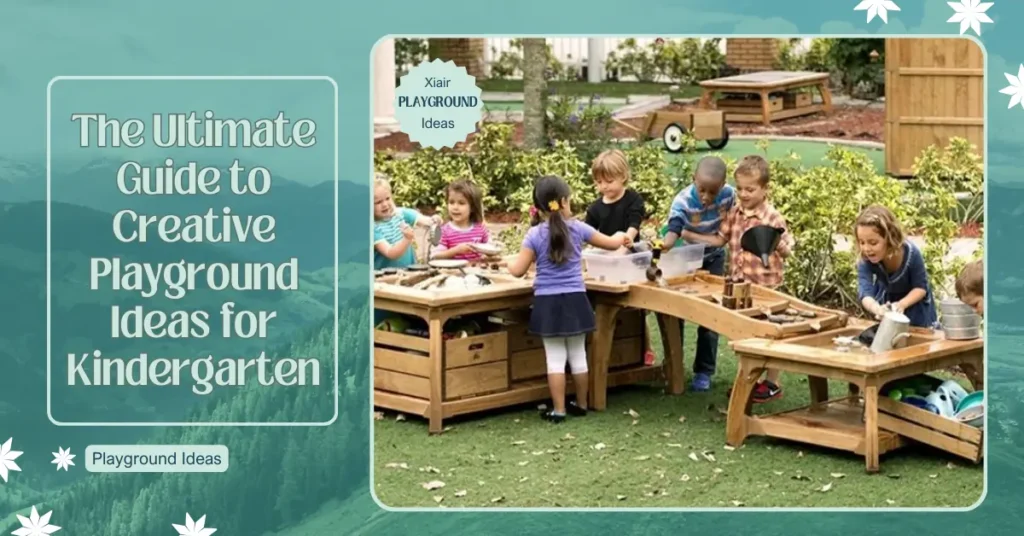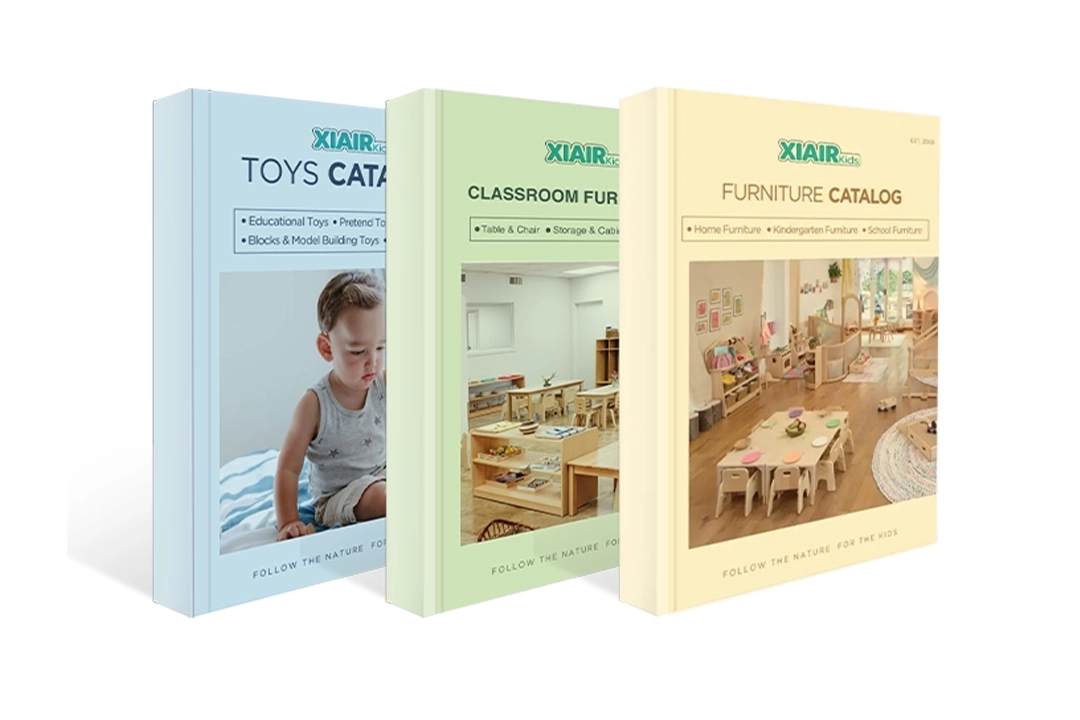Are you struggling to come up with engaging playground ideas for your kindergarten? Creating the perfect playground can be overwhelming, with so many options available. Don’t worry! We’ve got you covered with this ultimate guide.
This guide will help you understand various playground ideas and how to implement them effectively. We will cover everything from safety regulations to innovative equipment, ensuring your kindergarten has the best playground.
Let’s dive into the details and discover how to create an exciting and safe playground for young children.
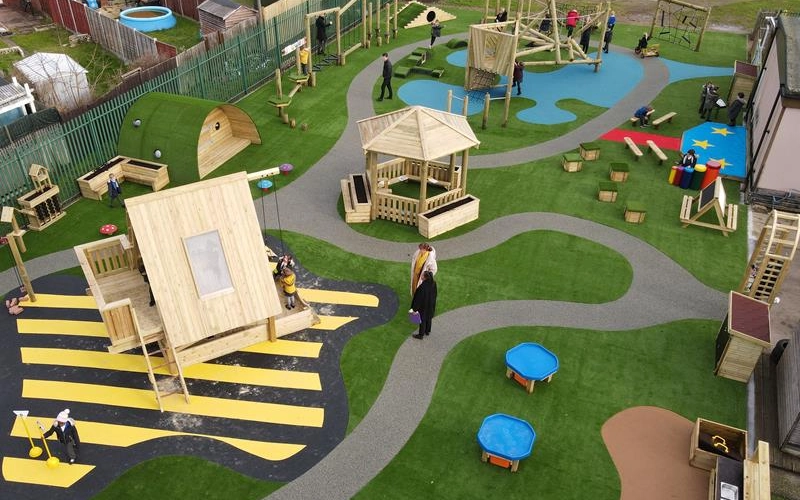
Understanding Playground Ideas and Children’s Gross Motor Skills
When planning a playground, it’s essential to consider how different playground ideas can help develop children’s gross motor skills. Gross motor skills are crucial for children’s physical development, including running, jumping, and climbing. Let’s explore this concept from a few different angles:
Enhancing Physical Development: Playground equipment like swings, slides, and climbing structures can significantly improve children’s gross motor skills. Swings help balance and coordination, while slides encourage climbing and spatial awareness. Climbing structures are excellent for developing upper body strength and coordination. Using balance beams and stepping stones can help children improve their balance and agility.
Different types of play equipment engage various muscle groups. For example, climbing structures work on upper body strength, while running areas improve cardiovascular health and leg strength. Including diverse equipment ensures comprehensive physical development. Gross motor skills children develop through preschool age include physical abilities like:
- Balance
- Coordination
- Strength
- Endurance
- Agility
- Spatial Awareness
- Flexibility
- Posture Control
- Body Awareness
- Reaction Time
Sensory Integration and Motor Skills: Including various textures and surfaces in your playground benefits sensory integration. Grass, sand, rubber, and wood chips provide different sensory experiences for children. These diverse surfaces help develop tactile senses, proprioception, body position, and movement awareness. Incorporating play equipment that encourages spinning, like merry-go-rounds or spinning seats, can enhance vestibular development, which is crucial for balance and spatial orientation.
Sensory play areas with water tables, sandboxes, and musical instruments stimulate children’s senses and support cognitive development. These areas allow children to explore textures, sounds, and basic scientific principles, enhancing sensory and motor skills.
Social and Emotional Development Through Play: Playgrounds are not just for physical development; they also play a crucial role in social and emotional growth. Group activities like playing on seesaws or participating in obstacle courses foster teamwork and cooperation. Children learn to take turns, share, and resolve conflicts, essential social skills.
Playing in a group setting can also help children build confidence and self-esteem. Successfully climbing a challenging structure or mastering a new activity can give children a sense of accomplishment. These experiences are vital for emotional development and building resilience.
Encouraging Creative and Imaginative Play: Creative and imaginative play is another critical aspect of playgrounds. Playhouses, forts, and themed play areas encourage children to play pretend, enhancing creativity and cognitive development. Such environments allow children to invent stories, roles, and scenarios, fostering imagination and problem-solving skills.
Incorporating elements like art stations, where children can paint or draw, and garden plots, where they can learn about plants and nature, further stimulates creativity. These activities provide a holistic play experience beyond physical development, encompassing mental and emotional growth.
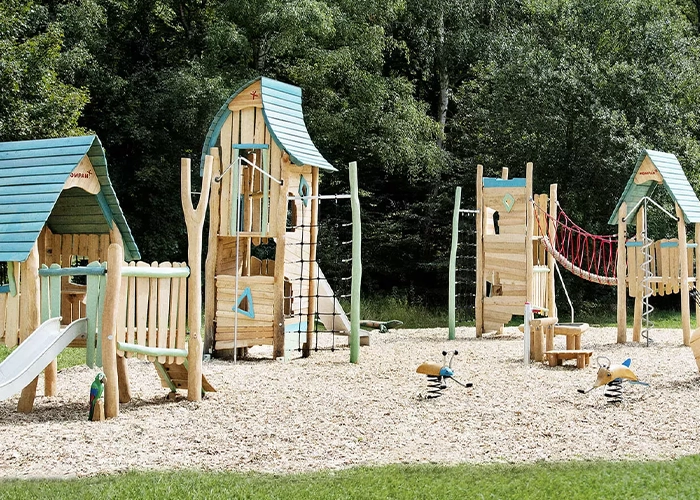
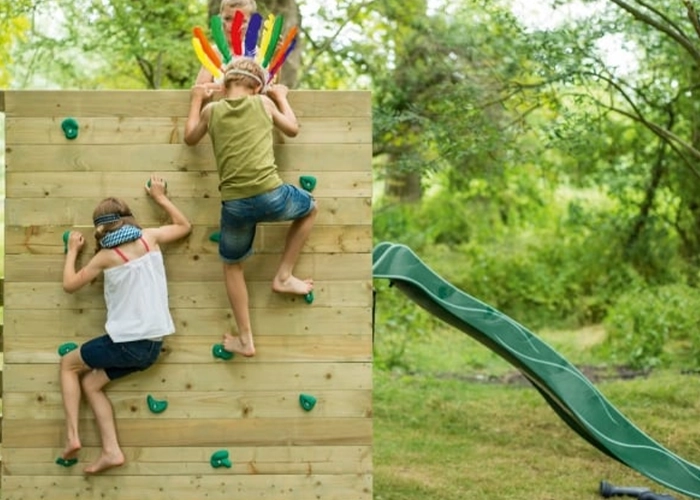
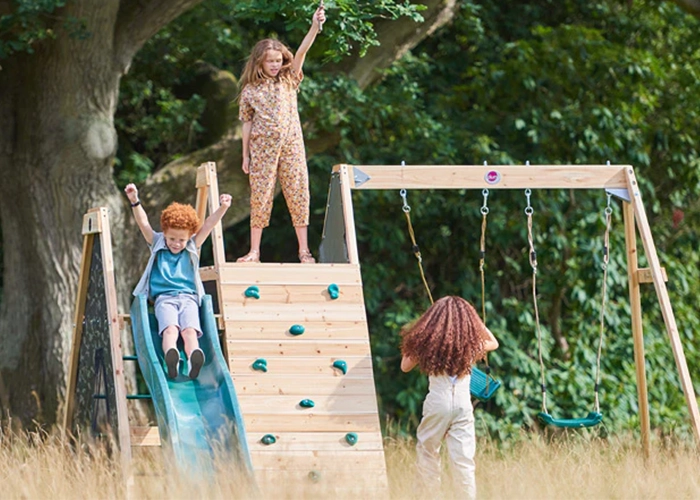
Playground Ideas: Regulations and Guidelines for Safety
Ensuring playground safety is crucial for creating a fun and secure environment for children. Following playground regulations and guidelines can help prevent injuries and promote healthy physical activity. Playground ideas must align with standards set by organizations like ASTM International and the Consumer Product Safety Commission (CPSC). These standards ensure equipment is safe, durable, and well-maintained.
Accessibility is another vital aspect. The Americans with Disabilities Act (ADA) mandates that playgrounds be inclusive, allowing children with disabilities to enjoy play spaces. This includes providing accessible pathways and equipment designed for all abilities.
Surface and flooring are critical components of playground safety. Using impact-absorbing materials like rubber mulch, sand, or engineered wood fiber helps cushion falls and reduce injury risks. Regularly maintaining these surfaces ensures they remain even and free from hazards such as sharp objects or debris.
Proper layout and spacing prevent overcrowding and collisions. Precise, safe pathways to and from playground equipment are essential. Adequate spacing between different pieces of equipment allows children to play without interfering with each other.
Supervision and regular inspections are necessary to maintain a safe playground. Constant adult supervision can quickly address any safety issues that arise. Routine checks and maintenance help identify and fix wear and tear or potential hazards, ensuring the playground remains in good condition.
Following local, national, and international standards, such as those from ASTM and CPSC, ensures the playground meets all safety regulations. By incorporating these playground ideas and guidelines, we can create a safe, inclusive, and enjoyable environment for all children, promoting physical activity and development in a secure setting.
Creating Your Playground with a Variety of Equipment Ideas
Creating a playground is not just about installing a few swings and slides. It’s about designing a dynamic environment where children can explore, learn, and grow. A well-rounded playground should offer a variety of equipment that caters to different interests, age groups, and developmental needs. The right mix of playground equipment can stimulate children’s physical, cognitive, social, and emotional development. This section will explore various equipment ideas to transform your playground into a vibrant, engaging, and inclusive space for all children.
When planning your playground, consider how children interact with their environment. Some children may be drawn to active play, while others prefer sensory or imaginative activities. A well-designed playground accommodates all these preferences by offering a range of play opportunities. The possibilities are endless, from traditional swings and slides to innovative sensory play areas and adventure zones. You can create a space that supports holistic child development by thoughtfully selecting and arranging playground equipment.
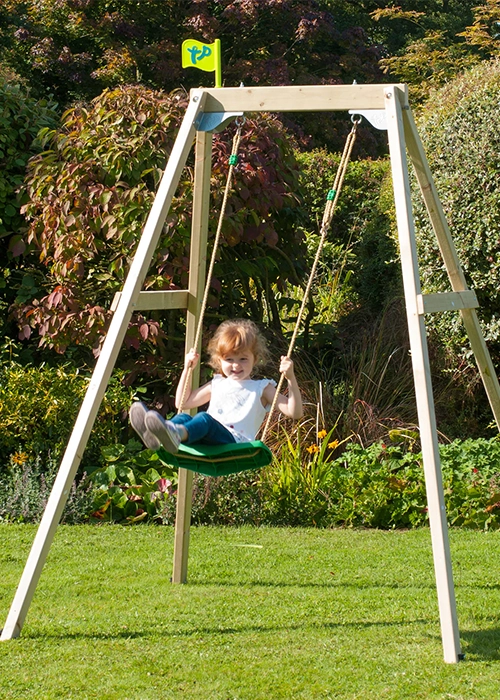
Swings: Balance and Coordination
Swings are a staple in playgrounds. They are not only fun but also excellent for developing balance and coordination. The rhythmic motion of swinging helps children learn timing and spatial awareness. Different swings, such as traditional belt swings, bucket swings for toddlers, and tire swings, can cater to various age groups and skill levels.
Adding a group swing can promote social interaction as children work together to swing back and forth. Swings can also be designed to accommodate children with special needs, ensuring inclusivity.
Slides: Climbing and Thrilling Fun
Slides are another essential component of playgrounds. They encourage climbing, which strengthens muscles, improves coordination, and provides thrilling fun as children slide down. There are many types of slides to consider:
- Straight Slides: Simple and fast, great for all ages.
- Curved Slides: Adds an element of surprise and fun.
- Tube Slides: Enclosed for a different sensory experience.
- Wave Slides: Adds bumps for extra excitement.
Incorporating slides of varying heights and shapes can keep children engaged and challenged. Ensuring the slides are made of durable, safe materials and have appropriate safety measures, like guardrails and soft landing areas, is crucial.
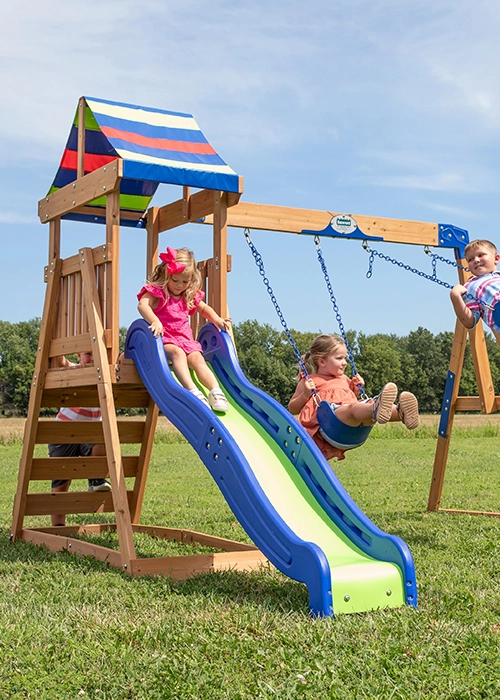
Climbing Structures: Strength and Coordination
Climbing structures are vital for developing upper body strength and coordination. These can include:
- Climbing Walls: Simulate rock climbing and can be designed for different skill levels, promoting physical strength and problem-solving skills as children figure out their routes.
- Rope Climbs: Encourage agility and upper body strength, offering a different texture and challenge than traditional climbing equipment.
- Ladders and Monkey Bars: Traditional but highly effective for physical development, helping children build arm strength and coordination.
- Nets and Webs: Provide a unique climbing challenge that can be fun and beneficial for developing gross motor skills and balance.
Combining these elements into a single climbing structure can create an engaging centerpiece for your playground. Integrating features like lookout towers or connecting tunnels can make the climbing experience even more exciting and adventurous.
Sensory Play Areas: Sandboxes and Water Play
Sensory play areas stimulate children’s senses and encourage creative play. Sandboxes and water play areas are particularly popular:
- Sandboxes: Great for digging, building, and imaginative play. They encourage fine motor skills as children manipulate sand to create various structures. Ensure they are covered when not in use to keep them clean.
- Water Play Areas: Splash pads, water tables, and fountains can cool children off on hot days and provide endless fun. These areas can include features like dams, water wheels, and spray jets to enhance the play experience.
Sensory play areas can also include mud kitchens, where children can pretend to cook using mud and water, enhancing their creativity and sensory development. These areas provide a multi-sensory experience that can be calming and therapeutic, especially for children with sensory processing disorders.
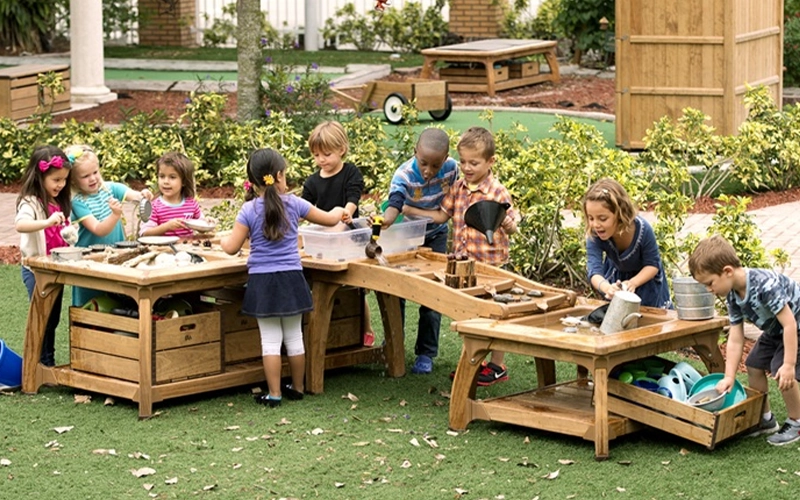
Adventure Play Areas: Obstacle Courses and Nature Play
Adventure play areas can provide challenging and exciting experiences for children. These can include:
- Obstacle Courses: Combine elements like tunnels, balance beams, stepping stones, and hurdles to create a fun and challenging course. Change the layout regularly to keep children engaged. Obstacle courses promote physical fitness and problem-solving as children navigate the different challenges.
- Nature Play Areas: Use natural elements like logs, rocks, and plants. These areas encourage exploration and interaction with nature, fostering an appreciation for the environment. Features like tree stumps for balancing, rock piles for climbing, and garden beds for planting can make nature play areas educational and engaging.
Adding elements like treehouses or wooden forts can also enhance the adventure aspect of the playground. Ensure that these areas are safe and well-maintained to prevent injuries. Nature play areas can also include quiet spaces with seating where children can observe nature and relax.
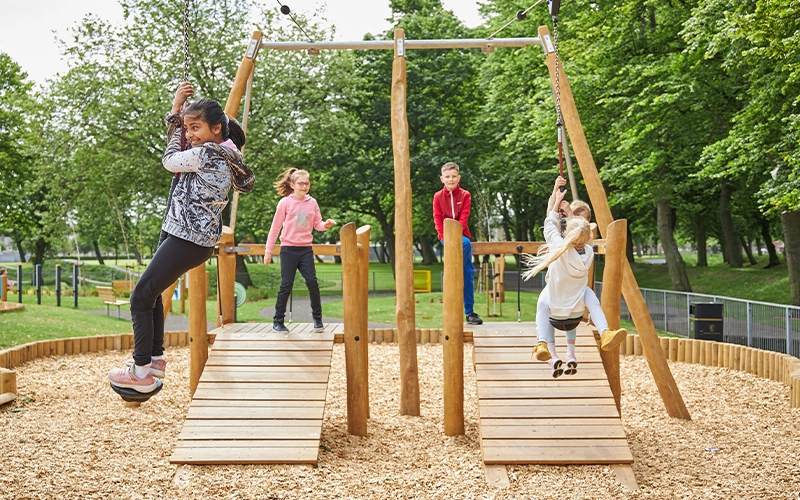
Inclusive Play Equipment
It’s vital to include accessible equipment for all children, including those with disabilities. This can include:
- Inclusive Swings: Designed for children with physical disabilities, ensuring they can enjoy swinging alongside their peers.
- Ramps and Wide Pathways: Ensure all areas of the playground are accessible, making it easier for children using wheelchairs or other mobility aids to navigate.
- Sensory Play Equipment: Like musical instruments or textured panels that can be enjoyed by children with sensory processing disorders. These elements can enrich all children’s experiences, promoting inclusivity and understanding.
Creating an inclusive playground ensures that all children can play together, promoting social integration and equal opportunities for fun and development. Including braille panels or interactive elements that engage different senses can make the playground more inclusive.
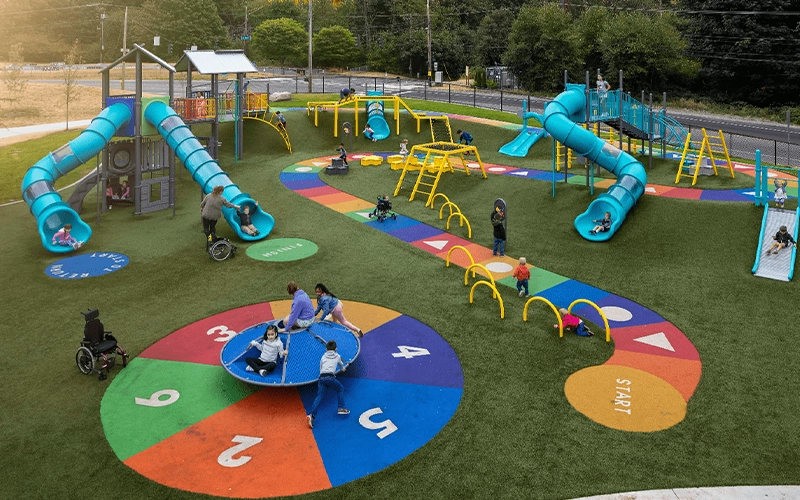
Educational and Themed Play Areas
Incorporating educational elements into the playground can enhance learning opportunities. These can include:
- Interactive Boards: With alphabets, numbers, or maps to encourage learning through play. Educational panels can be incorporated into existing structures or standalone features.
- Themed Play Zones: Areas based on favorite stories, characters, or historical periods can make playtime more engaging and educational. Themes like “Under the Sea,” “Space Adventure,” or “Jungle Exploration” can spark children’s imaginations and provide a backdrop for creative play.
Themed areas can include props and elements that encourage role-playing and storytelling, making learning fun and interactive. Including educational signage or interactive elements can add a layer of understanding to the play experience.
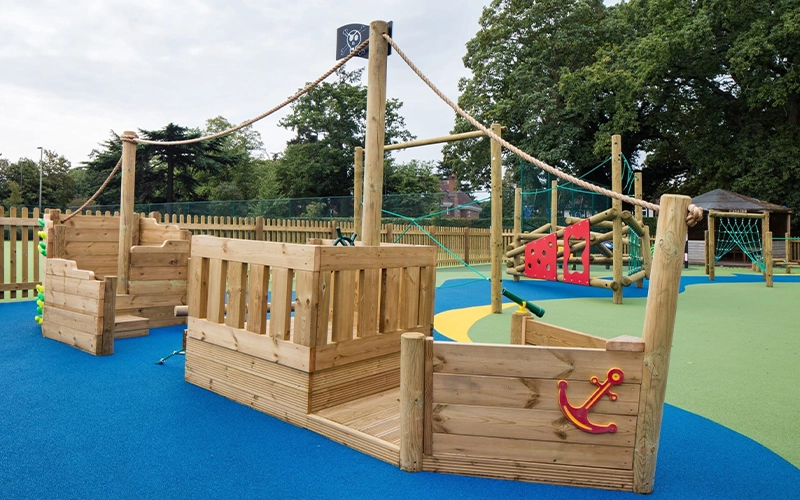
Quiet and Rest Areas
Not all play needs to be high-energy. Including quiet zones with benches and shade allows children to rest and recharge. These areas can include:
- Reading Corners: With books and comfortable seating, literacy is encouraged, and a quiet space for reflection is provided.
- Art Stations: These are where children can draw or paint, fostering creativity and providing a calm, focused activity.
- Gardening Areas: Children can learn about plants and nature, promoting responsibility and environmental appreciation.
Creating spaces for quiet activities ensures children have a balanced play experience, catering to their need for active and calm play. These areas can also provide a place for children to take a break if they feel overwhelmed, ensuring the playground is a supportive and inclusive environment.
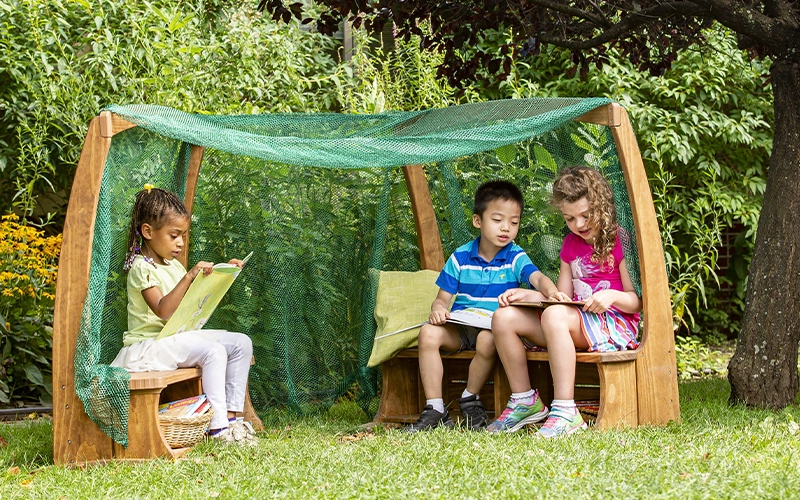
Incorporating various equipment and play areas in your playground can create a dynamic, engaging, and inclusive environment. Each element contributes to children’s physical, cognitive, and social development, from swings and slides to sensory and adventure play areas. Thoughtfully selecting and arranging this equipment allows you to create a playground with endless fun, learning, and growth opportunities.
Innovative Playground Ideas for Building the Perfect Play Space
Creating the perfect playground involves innovative playground ideas and thoughtful planning. By carefully selecting and arranging playground components, you can build a play area that is engaging, safe, and suited to children’s developmental needs. Here are some critical steps and ideas to help you achieve this.
Start with a Complete Play System
Choosing a complete play system is a great way to start. These systems provide a cohesive play experience with various activities, ensuring compatibility and ease of installation. Complete play systems often include swings, slides, and climbing structures, promoting balanced play that supports physical, cognitive, and social development. This approach ensures your playground is well-rounded and engaging for all children.
Enhance with Additional Components
Enhancing your playground with additional components can make it more exciting. Sensory play areas, like sandboxes and water tables, stimulate children’s senses. Adding adventure elements such as obstacle courses and balance beams encourages physical activity and coordination. Nature-inspired features, including logs, rocks, and plants, foster a connection with nature and promote exploration. These playground ideas create a diverse and exciting environment that caters to different interests and developmental stages.
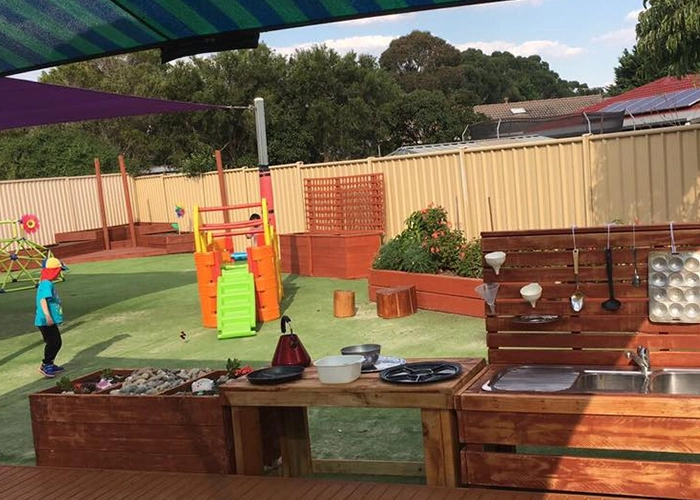
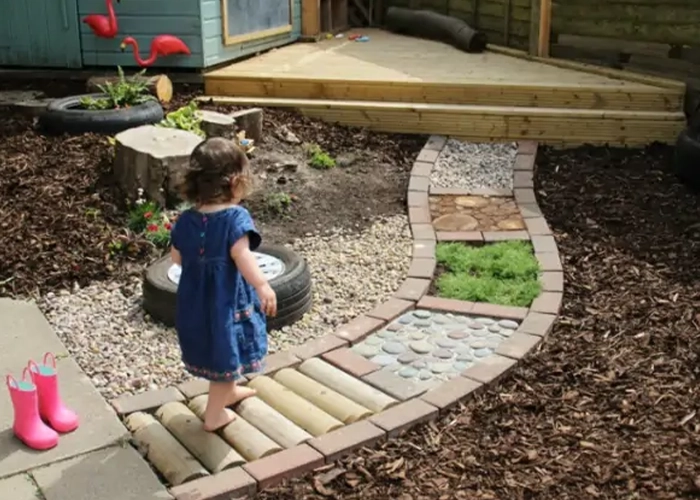
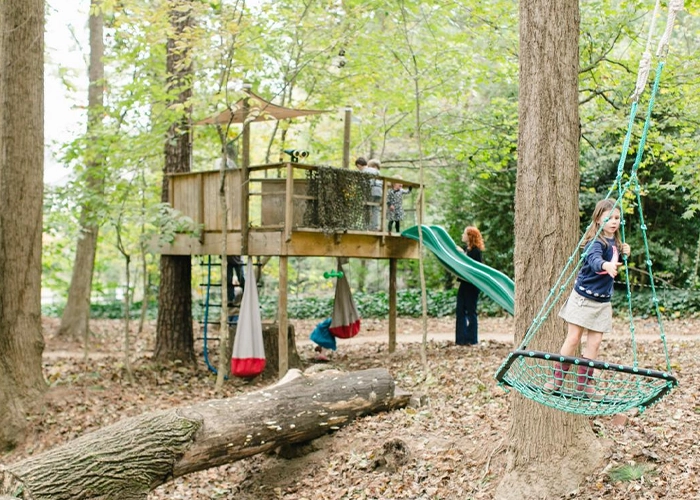
Customize Your Arrangement
Creating your arrangement of playground equipment allows for a personalized play area. This method lets you choose equipment that fits your specific space and meets the unique needs of the children. You can design a play environment that maximizes engagement and benefits by selecting and arranging different pieces. Custom arrangements provide the flexibility to incorporate unique features and themes, making the playground a special place for its users.
Commission a Custom Design from Xiar
For a truly unique and tailored playground, consider commissioning a custom design from Xiair World. Our playground designers and child development specialists will work with you to create a space that perfectly meets your needs and preferences. We can incorporate innovative playground ideas like bespoke climbing structures, interactive art installations, and specialized sensory play areas. A custom design ensures your playground stands out and offers children a unique, engaging environment.
Contact us today to start designing the perfect playground for your community. Let us help you create a space where children can play, learn, and grow.
By following these steps and incorporating these playground ideas, you can build the perfect play space that is innovative and tailored to your community’s needs. Whether starting with a complete play system, adding components, customizing your arrangement, or commissioning a design, thoughtful planning and creativity will ensure your playground is where children can thrive.
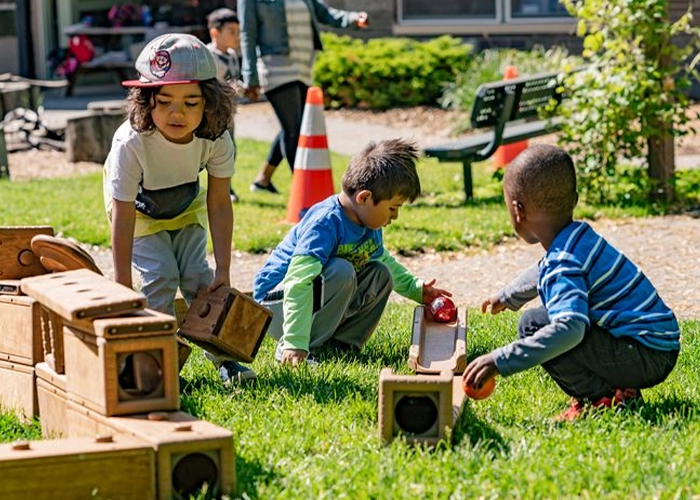
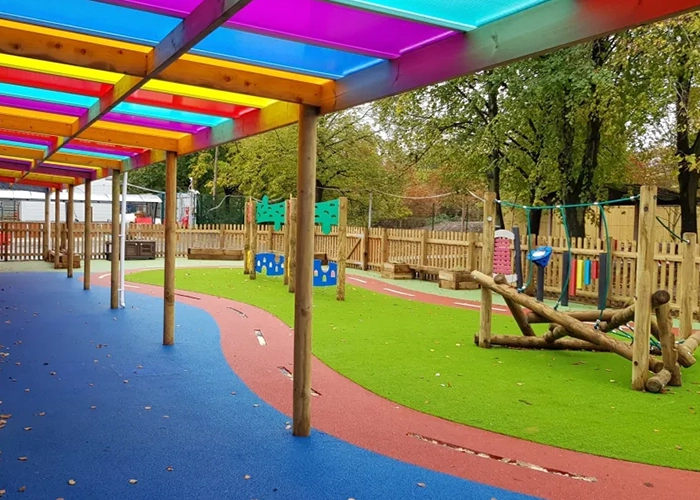
Organizing an Early Childhood Playground: Practical Ideas
Creating a well-organized playground for young children involves thoughtful planning and innovative ideas. A well-designed playground can enhance safety, promote various play activities, and ensure a positive experience for children and supervisors. Here are some practical ideas to help you organize an effective early childhood playground.
- Designate Separate Play Areas: One of the most effective playground ideas is to designate separate areas for different types of play. Creating distinct zones allows you to manage activities more efficiently and ensure all children can access their preferred play activities without overcrowding. For example, you can have dedicated areas for active, quiet, and sensory play. Active play areas can include climbing structures and slides, while quiet play areas might have sandboxes or reading corners. Sensory play areas can feature water tables and musical instruments. This separation helps prevent conflicts and ensures children can safely engage in their chosen activities.
- Incorporate Environmental Features: Integrating environmental features into your playground design can significantly enhance the play experience. Natural elements like trees, shrubs, and rocks can create a more inviting and stimulating environment. These features provide shade, improve aesthetics, and offer nature-based play and exploration opportunities. Additionally, consider adding garden plots or small wildlife habitats to teach children about nature and responsibility. Incorporating natural materials such as wood and stone in play structures can blend the playground with its surroundings and make it more appealing.
- Plan Access Points and Pathways: Clear and well-planned access points and pathways are crucial for a well-organized playground. Ensure there are designated entry and exit points that are easy to navigate. Pathways should be wide enough to accommodate strollers and wheelchairs, promoting inclusivity and accessibility. Use different materials or colors for pathways to distinguish them from play areas, guiding children and supervisors throughout the space. Strategic placement of pathways can also help manage the flow of children between different play zones, reducing congestion and enhancing safety.
- Provide Ample Seating and Good Sightlines: Providing ample seating and ensuring good sightlines are essential for supervision and comfort. Benches and picnic tables around the playground allow caregivers to rest while closely monitoring the children. Seating areas should offer clear views of the playground, enabling supervisors to monitor multiple places simultaneously. Shade structures over seating areas can protect adults from the sun, making supervision more comfortable. Additionally, seating areas can double as social spaces where children and adults can gather, promoting community interaction.
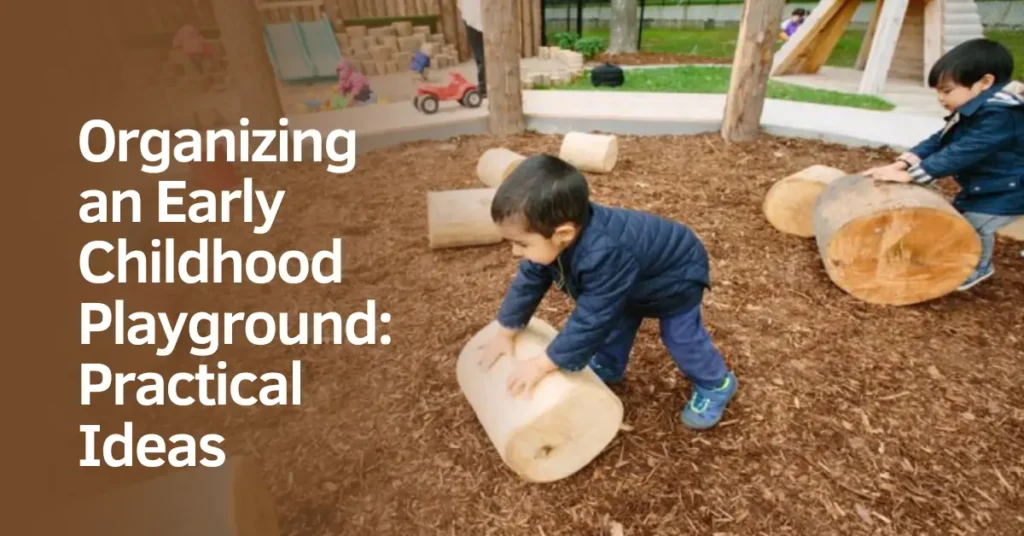
By implementing these playground ideas, you can create a well-organized, engaging, and safe environment for early childhood play. Properly designated areas, integrated environmental features, clear access points, and ample seating all contribute to a playground that meets the needs of children, caregivers, and the broader community.
Tips for a Successful Playground Design Process with Creative Ideas
Designing a great playground needs careful planning and creative playground ideas. Here are some simple tips to make a fun, safe, and exciting space.
- Get Help from Experts: Ask for help from playground design experts. They can give you good ideas and ensure your playground meets safety rules. Experts know the best ways to use your space and can help you add special features that make your playground unique.
- Put Safety First: Safety is very important. Choose safe, solid materials and make sure all equipment meets safety standards. Use soft surfaces like rubber mulch to cushion falls. Regularly check and maintain the equipment to keep it safe for kids.
- Make It Look Nice: A playground should look fun and inviting. Choose a theme and bright colors that kids will love. Adding murals and themed equipment can make the playground more enjoyable. A good-looking playground attracts more families and becomes a favorite spot in the community.
- Know Your Space: Understand the size of your playground area. Whether it’s a small park or a big schoolyard, knowing the space helps you pick the right equipment. Make sure there’s enough room for kids to play safely without crowding.
- Think About Play Value: Choose equipment that encourages different types of play. Include things for climbing, swinging, sliding, and imaginative play. The more varied the equipment, the more kids will enjoy and benefit from the playground.
- Plan Your Budget: Know how much money you can spend on your playground—plan for equipment, installation, and maintenance costs. Focus on essential features that ensure safety and fun. Find cost-effective ideas that offer good quality without breaking the bank.
- Buy Quality Equipment: Good quality equipment lasts longer and is safer. It stands up to heavy use and bad weather. Investing in durable materials saves money on repairs and replacements over time. Quality equipment makes the playground experience better for all kids.
You can design a successful playground by following these simple tips and using creative ideas. A well-planned playground is safe and fun and an excellent place for the community to enjoy.
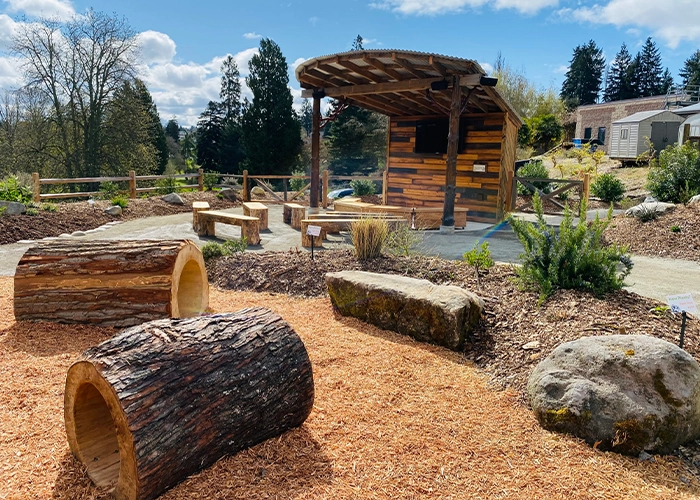
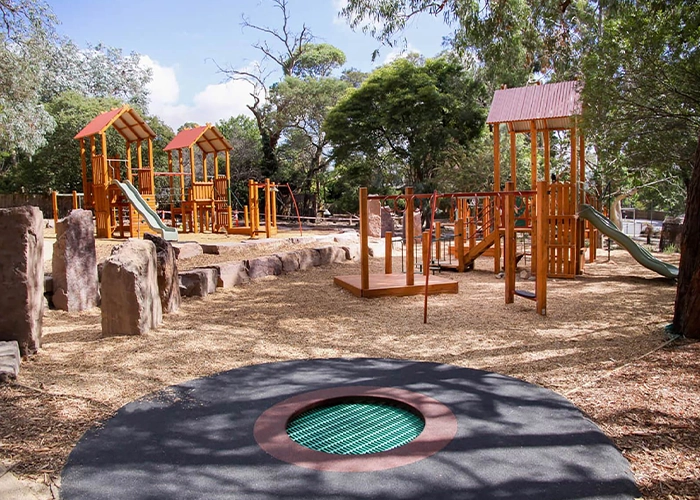
Quality Playground Equipment for Young Children from Xiair World
For the best playground equipment, choose Xiair World. We offer high-quality, safe, and fun equipment for young children. Our products are designed to support physical, cognitive, and social development. With our expert advice and custom designs, you can create the perfect play space for your community. Contact us today to start building a playground that children will love and parents will trust.
By following the tips and playground ideas outlined in this guide, you can design a safe and engaging playground. Remember, a well-planned playground is more than just a play area—it’s a place where children can learn, grow, and have fun. Let Xiair World help you create a vibrant, enjoyable, and secure playground that will be a cherished part of your community for years.

